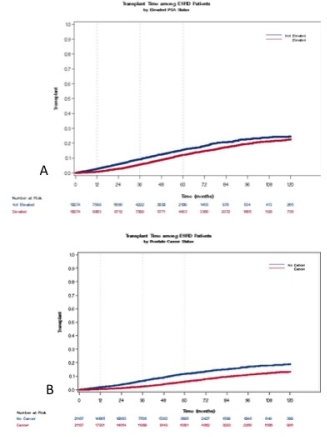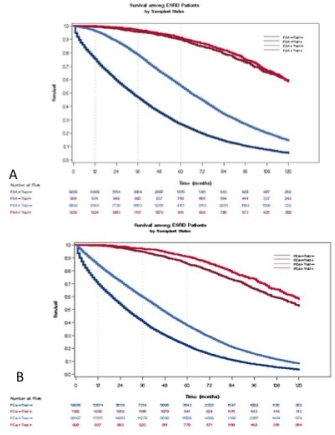Impact of Elevated PSA, and Prostate Cancer in ESRD on Time to Transplant, and Survival
N. Sarabu,1 N. Schiltz,2 D. Hricik.1
1University Hospitals of Cleveland, Cleveland, OH
2Case Western Reserve University, Cleveland, OH.
Meeting: 2018 American Transplant Congress
Abstract number: 144
Keywords: Kidney, Malignancy, Survival
Session Information
Session Name: Concurrent Session: Kidney: Cardiovascular and Metabolic - 1
Session Type: Concurrent Session
Date: Sunday, June 3, 2018
Session Time: 4:30pm-6:00pm
 Presentation Time: 5:42pm-5:54pm
Presentation Time: 5:42pm-5:54pm
Location: Room 303
Introduction: Despite concerns for over-diagnosis and over-treatment from prostate cancer screeening, transplant centers perform it. We studied effect of Elevated PSA, and Prostate cancer on time to transplant and survival in ESRD.
Methods: Utilizing USRDS data, we identified 10, 274 and 21, 189 male patients between age 40, and 75 that had claims for ICD 9 codes for 'elevated PSA', and 'prostate cancer' respectively. We selected 1:1 controls using propensity based matching for risk adjustment on baseline demographic, socioeconomic, and comorbidity variables. We used Kaplan Meier (KM) method to generate survival curves for time-to-transplant, and time-to-death. Time zero is date of ESRD diagnosis on 2728. Both outcomes were right censored at last date of follow up, and time to transplant was also censored at death. For time-to-transplant, we stratified by elevated PSA, and prostate cancer. For time-to-death, we stratified by transplant status along with elevated PSA, and prostate cancer. We used Cox proportional hazards model to calculate hazard ratios.
Results:  illustrates KM cumulative incidence of kidney transplant stratified by elevated PSA (panel A) and prostate cancer (panel B).
illustrates KM cumulative incidence of kidney transplant stratified by elevated PSA (panel A) and prostate cancer (panel B).  illustrates KM time-to-death stratified by elevated PSA, and transplant status (panel A), and prostate cancer and transplant status (panel B).
illustrates KM time-to-death stratified by elevated PSA, and transplant status (panel A), and prostate cancer and transplant status (panel B).
Elevated PSA had 26% less likelihood of transplantation (HR:0.74 (0.68-0.80)) and prostate cancer had 50% less likelihood of transplantation (HR: 0.50 (0.46-0.54)). Transplantation reduced mortality by 86% for patients with elevated PSA, and prostate cancer with HR:0.14 (0.68-0.80) and HR:0.14 (0.13-0.15) respectively.
Conclusion: Since survival post-transplant is similar regardless of elevated PSA or prostate cancer status, screening may delay life saving kidney transplant.
CITATION INFORMATION: Sarabu N., Schiltz N., Hricik D. Impact of Elevated PSA, and Prostate Cancer in ESRD on Time to Transplant, and Survival Am J Transplant. 2017;17 (suppl 3).
To cite this abstract in AMA style:
Sarabu N, Schiltz N, Hricik D. Impact of Elevated PSA, and Prostate Cancer in ESRD on Time to Transplant, and Survival [abstract]. https://atcmeetingabstracts.com/abstract/impact-of-elevated-psa-and-prostate-cancer-in-esrd-on-time-to-transplant-and-survival/. Accessed December 16, 2025.« Back to 2018 American Transplant Congress
